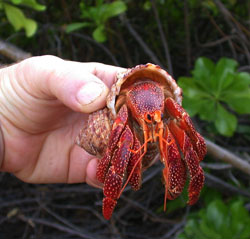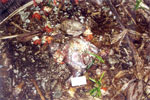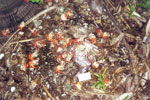 |
November 11, 2003
| A Moveable Feast |
During the Niku IIII expedition, forensic anthropologist Dr. Karen Burns conducted an experiment intended to provide some initial rudimentary data on the rate at which dead animals decay in the island environment. Our interest in the subject stems from the discovery, in 1940, of the partial skeleton of a castaway suspected at the time as being that of Amelia Earhart (see Amelia Earhart’s Bones and Shoes).
| In his April 1941 report (see The Bones Chronology), Dr. David Hoodless, the British colonial physician who examined the bones, stated that the remains found on Gardner Island consisted of: | |||
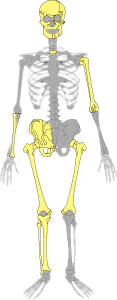 |
1. |
a
skull with the right zygoma and malar bones broken off; |
|
|
2. |
mandible
with only four teeth in position; |
||
|
3. |
part
of the right scapula; |
||
|
4. |
the
first thoracic vertebra; |
||
|
5. |
portion
of a rib (? 2nd right rib); |
||
|
6. |
left
humerus; |
||
|
7. |
right
radius; |
||
|
8. |
right
innominate; |
||
|
9. |
right
femur; |
||
|
10. |
left
femur; |
||
|
11. |
right
tibia; |
||
|
12. |
right
fibula; |
||
|
13. |
the
right scaphoid bone of the foot. |
||
| Dr. Hoodless noted that “From this list it is seen that less than half of the total skeleton is available for examination.” Considerably less than half. Officially there are 206 bones in the human body, but that includes 2 kneecaps, 6 tiny bones in the ears, 54 bones in the hands and 52 bones in the feet – so 79 of the 92 larger bones were missing, including 10 of the major bones, such as the left innominate (the left half of the pelvis). Where did they go? | |||
In a telegram to his superiors dated October 17, 1940 (see The Bones Chronology), the colonial officer who found the bones, Gerald Gallagher, wrote:
All small bones have been removed by giant coconut crabs which have also damaged larger ones. Difficult to estimate age bones owing to activities of crabs but am quite certain they are not less than four years old and probably much older.Doctor Hoodless later concurred:
All these bones are very weather-beaten and have been exposed to the open air for a considerable time. Except in one or two small areas all traces of muscular attachments and the various ridges and prominences have been obliterated.And another colonial doctor who saw the bones, Dr. Lindsey Isaac, was of the opinion that the “bones have been in sheltered position for upwards of 20 years and possibly much longer.”
There is nothing in their backgrounds to suggest that any of these men had experience in assessing the age of bones found on Pacific islands. How accurate were their judgments? Do coconut crabs (Birgus latro) really remove bones? If so, how long does it typically take them to reduce a human skeleton to the condition of the one found by Gallagher? Clearly some experimentation was called for.
|
Above, a strawberry land hermit crab. TIGHAR photo by R. Gillespie.
|
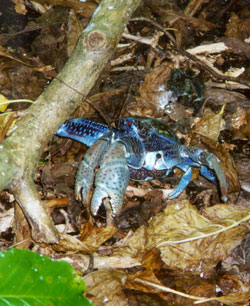 |
| Birgus latro, the Coconut or Robber crab, is the world’s largest land crab and is now considered an endangered species. We’ve seen adults on Nikumaroro that are easily 18 inches across the back. It is believed that individuals can live up to 60 years or longer – no one really knows. The large adults tend to be elusive. The much more numerous strawberry land hermit crabs, coenobita perlatus, are everywhere. | |
The team’s dedication to scientific inquiry did not extend to sacrificing one of our expedition members so we had to find a substitute for a human body. The preferred stand-in for such experiments is a pig because pigs are hairless omnivores with roughly the same body mass and bone size as humans. Our plan was for Dr. Burns to procure a suitable porker in American Samoa and our ever-gracious hosts aboard our chartered expedition vessel, Nai’a, had even constructed a cage for the purpose of transporting the subject of the experiment to Nikumaroro. Unfortunately for TIGHAR (but fortunately for Porky) negotiations for the purchase of the pig broke down when the patriarch of the Samoan family learned that the animal would not be eaten by people but by crabs. Such a fate was deemed unsuitable and the deal was off.
Plan B was less satisfactory but more politically correct. A shoulder of lamb from the butcher shop would have to do. On August 29, 2001 Dr. Burns laid out the lamb shoulder at the foot of a coconut palm about fifty feet back in the treeline from the beach and a couple hundred yards south of the landing where we came ashore everyday. The idea was to pick a spot that was convenient for monitoring but far enough away so as not to be influenced by the team’s other activities. The photos below show the progression; click on each picture to open a much larger version in a new window.
|
August 29 – Day 1
Fresh meat. |
August 31 – Day 3
Attention from several hermit crabs and one purple “teenager” (just to the right of the lamb shoulder) who is almost ready to go without his shell. |
September 1 – Day 4
Feeding frenzy. The teenager doesn’t seem to have moved since yesterday. |
September 2 – Day 5
The flesh is gone but the ribs and the limb (shoulder blade and leg bones) are still attached to each other by ligaments. |
|
September 3– Day 6
The ligaments have been eaten away exposing bare bone. |
September 4 – Day 7
One week. The bones begin to move. |
September 6 – Day 9
The joints between individual bones are being attacked and the limb is becoming disarticulated (disconnected). |
September 10 – Day 13
In less than two weeks everything is gone. |
The lamb shoulder experiment, rudimentary as it was, produced some surprising results and raised some important questions.
- No adult crabs were ever seen at the site. It appears that the devouring of the meat and the disarticulation and removal of the bones was carried out entirely by hermit crabs and young coconut crabs, but we do not know this for sure. It’s not that the adults outgrow their taste for meat. We’ve seen a big adult coconut crab dining on a dead rat that he had hauled high up onto a tree limb leopard-style (yes, coconut crabs are great tree climbers). But the adult coconut crabs are definitely more reclusive than juveniles and hermit crabs. They may be appearing only under cover of night – a question that could be answered by a nighttime video during the next experiment.
- In most environments the first-on-the-scene scavengers are blowflies but on Nikumaroro the hermit crabs beat them to it and so completely cover the carcass that the flies have almost nowhere to land.
- Something on the island can and does go off with bones of the size of those in the lamb shoulder. We suspect that it was the young coconut crabs but we did not actually see them do it. We’ve seen them carry off smaller (pork chop) bones but we’ve also seen a dead fish completely skeletonized by tiny hermit crabs without a bone disturbed. The coconut crabs weren’t interested. Do they not like fish? One does not usually think of crabs as picky eaters.
The results of the preliminary experiment suggest that the island’s reductive environment acts far more rapidly than the British colonial officials imagined. Indeed, the major accelerating factor appears to be the presence of a large population of crabs. Further research may establish that the castaway whose bones were found on Nikumaroro had almost certainly been dead a matter of months, not years. If so, the implications are disturbing. The island was continuously inhabited from December 1, 1938. The skull was found in late April 1940 – nearly a year and a half later. Was the castaway alive after the island was inhabited but so mentally incapacitated as to avoid contact with strangers? Such a reaction to prolonged isolation is not unheard of.
As always, more research is needed. The full decomposition experiment is one of the tasks planned for the Niku V expedition.
